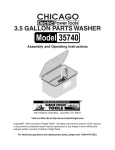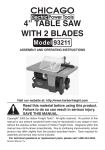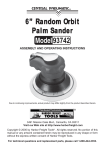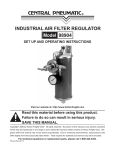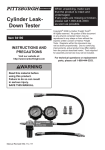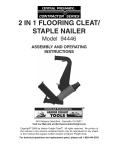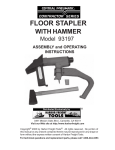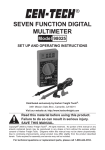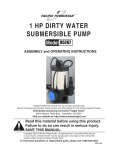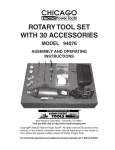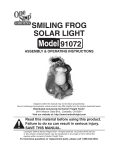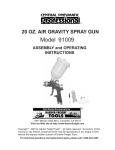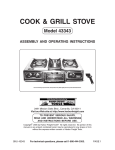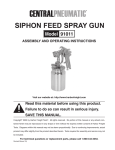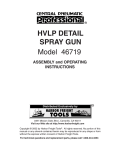Download Harbor Freight Tools 93119 User's Manual
Transcript
2-1/2 GALLON PAINT POT 93119 ASSEMBLY and OPERATING INSTRUCTIONS ® 3491 Mission Oaks Blvd., Camarillo, CA 93011 Visit our Web site at http://www.harborfreight.com To prevent serious injury, Read and understand all warnings and instructions before use. Copyright© 2005 by Harbor Freight Tools® . All rights reserved. No portion of this manual or any artwork contained herein may be reproduced in any shape or form without the express written consent of Harbor Freight Tools. For technical questions and replacement parts, please call 1-800-444-3353. Specifications Maximum Pressure 80 PSI Air Inlet 1/4” NPT Working Pressure 30-60 PSI Net Weight 20.5 lb. Tank Capacity 2.5 gallons Dimensions 93/4” Diameter x 181/2” Save This Manual You will need the manual for the safety warnings and precautions, assembly instructions, operating and maintenance procedures, parts list and diagram. Keep your invoice with this manual. Write the invoice number on the inside of the front cover. Keep the manual and invoice in a safe and dry place for future reference. Safety Warnings and Precautions WARNING: When using tool, basic safety precautions should always be followed to reduce the risk of personal injury and damage to equipment. Failure to observe these warnings and precautions could result in explosive failure of the pot, its components or attachments and in serious injury to self or others. Read all instructions before using this tool! 1. Keep work area clean. Cluttered areas invite injuries. 2. Observe work area conditions. Do not use machines or power tools in damp or wet locations. Don’t expose to rain. Keep work area well lighted. Do not use electrically powered tools in the presence of flammable gases or liquids. 3. Keep children and animals away. Children must never be allowed in the work area. Do not let them handle machines, tools, or hoses. 4. Store idle equipment. When not in use, tools must be stored in a dry location to inhibit rust. Always lock up tools and keep out of reach of children. 5. Do not force tool. It will do the job better and more safely at the rate for which it was intended. Do not use inappropriate attachments in an attempt to exceed the tool capacity. 6. Use the right tool for the job. Do not attempt to force a small tool or attachment to do the work of a larger industrial tool. Do not use a tool for a purpose for which it was not intended. 7. Dress properly. Do not wear loose clothing or jewelry as they can be caught in moving parts. Protective, electrically nonconductive clothes and nonskid footwear are recommended when working. Wear restrictive hair covering to contain long hair. 8. Use eye and ear protection. Always wear ANSI-approved impact and chemical splash safety goggles. Coatings can produce eye irritation. When cleaning tools exercise caution when using solvents. They can be forcefully ejected from the tool’s nozzle and REV 06/06 SKU 93119 For technical questions, please call 1-800-444-3353. Page air passages. Wear an ANSI-approved dust mask or respirator when working around chemical mist. 9. Do not overreach. Keep proper footing and balance at all times. Do not reach over or across running machines. 10. Maintain tools with care. Keep tools clean for better and safer performance. Follow instructions for lubricating and changing accessories. Inspect tool hoses periodically and, if damaged, have them repaired by an authorized technician. The handle must be kept clean, dry, and free from oil and grease at all times. 11. Disconnect power. Unplug compressor when not in use. 12. Remove adjusting keys and wrenches. Check that keys and adjusting wrenches are removed from the tool or machine work surface before plugging it in. 13. Avoid unintentional starting. Do not carry any tool with your finger on the trigger, whether it is plugged in or not. 14. Stay alert. Watch what you are doing. Use common sense. Do not operate any tool when you are tired. 15. Check for damaged parts. Before using any tool, any part that appears damaged should be carefully checked to determine that it will operate properly and perform its intended function. Check for alignment and binding of moving parts; any broken parts or mounting fixtures; and any other condition that may affect proper operation. Any part that is damaged should be properly repaired or replaced by a qualified technician. Do not use the tool if any valve does not operate properly. 16. Replacement parts and accessories. When servicing, use only identical replacement parts. Use of any other parts will void the warranty. Only use accessories intended for use with this tool. Approved accessories are available from Harbor Freight Tools. 17. Do not operate tool if under the influence of alcohol or drugs. Read warning labels on prescriptions to determine if your judgment or reflexes are impaired while taking drugs. If there is any doubt, do not operate the tool. 18. Do not spray near open flames, pilot lights or heaters, or any other heat source. Most solvents and coatings are highly flammable, particularly when sprayed. Always make sure that the work area is well ventilated. 19. Do not smoke while working with spraying tools. Do not spray in an area where lit cigarettes or cigars are present. Extinguish all smoking materials before using or cleaning the spray tool. 20. Do not use air pressure loads which exceed the working pressure (60 PSI). Exceeding the working pressure will cause the safety valve to release air, if it is working properly, in order to prevent the tank from exceeding it’s maximum pressure. Exceeding the Tank’s maximum pressure can cause the pressure pot to rupture or explode. 21. During each use, pull the ring on the safety valve to check that it operates freely and relieves air pressure. If the safety valve is stuck, does not operate freely, or does not relieve air pressure, replace the valve. REV 06/06 SKU 93119 For technical questions, please call 1-800-444-3353. Page 22. Do not discard or make any alterations to the safety valve. Tampering with, welding or drilling the pot can weaken it. 23. CAUTION: Do not use abrasive, corrosive or rust inducing materials with this pot. It is not designed for those materials. To use them can damage the pot’s internal parts. 24. Industrial applications must follow OSHA requirements. 25. Read all information concerning coating products and cleaning solvents. Chlorinated solvents, such as 1-1-1 Trichloroethane and Methylene Chloride (also known as methyl chloride) can chemically react with aluminum and explode. Many paint sprayers contain aluminum. If you are in doubt about potential chemical reactions, contact the coating or solvent manufacturer. 26. Check all seals before connecting the spray tool to the air supply. 27. Always ensure that the lid is fully attached to the can. 28. Always ensure that the retaining ring is screwed past the first thread. 29. Always ensure that the air supply is fully attached. 30. Do not use wrenches, pliers or other tools to tighten pot clamps. Use only the torque you can apply with your hands. 31. WARNING: Never release the lid while the pot is pressurized. Unpacking When unpacking, check to make sure that all the parts are included. If any parts are missing or broken, please call Harbor Freight Tools at the number on the cover of this manual. If any part of the machine is missing or broken, please, call Harbor Freight Tools at the number on the front cover, as soon as possible. SKU 93119 For technical questions, please call 1-800-444-3353. Page Operation Efficient and easy use of the pressurized pot depends on the careful performance of the steps required to prepare the pot for use, to fill the pot, and to operate the pot. Preparing the Pot for Use 1. Follow the manufacturer’s directions when mixing and preparing the paint or coating. 2. Strain the paint using a fine mesh screen to keep foreign matter and lumps from clogging the pot’s passageways. NOTE: Before using, it is recommended that the air supply line be passed through a filter to remove any possible dirt, water, or oil from the line. Filling the Pot Refer to the parts assembly illustration and the parts list on page 9 while performing the following steps: 1. Relieve all air pressure in the pot by pulling the ring on the safety valve (9). Pull the ring until the pressure bleeds down. 2. Remove the lid assembly by loosening the thumb screws (13) and tipping the lid clamps back. 3. Set the lid assembly aside. 4. Pour the prepared and strained paint into the pot. 5. Replace the lid assembly (3), and tighten the clamps and thumb screws. 6. Connect the air supply hose to the air inlet fitting on the pot regulator. 7. Attach the atomization air hose to the air outlet fitting, which is directly opposite the air inlet fitting. Gauge (5) Handle (10) Adapter, Air Inlet (4) T-handle Adjusting Screw Safety Valve (9) Regulator (6) Adapter, Air Outlet (4) Fluid Outlet Adapter (18) Thumb screw (13) Yoke Assy Lid Clamp (14) SKU 93119 For technical questions, please call 1-800-444-3353. Page WARNING: Always make sure that the equipment connected to the pot or hose outlet has a higher pressure rating than the regulated air pressure in the pot. Operating the Pot 1. Turn ON the air supply at the recommended PSI range (30-60 PSI). 2. Adjust the paint pressure by turning the T-handle adjusting screw (on regulator) clockwise to increase pressure and counterclockwise to decrease the pressure. 3. Adjust the atomization air for the spray by using the regulator on the pot. 4. Operate the spray gun according to the manufacturer’s instructions. 5. Clean the pot, paint hose and spray gun as soon as the job is done or is finished for the day. 6. If the pot is not operating properly, refer to the Troubleshooting section on page 8. Maintenance Maintenance of the Paint Pot consists of cleaning it thoroughly after each use by performing the following procedures: 1. Turn OFF the main air supply to the pot. 2. Relieve all pressure from the pot by turning the regulator T-handle counterclockwise, and then pull the ring on the safety valve until the pressure bleeds down. 3. Loosen the Thumb Screws and tip the lid clamps back. 4. Tip the pot lid to one side. 5. Loosen the spray gun air cap retaining ring about three turns. 6. Turn on the air supply. 7. Cup a cloth over the spray gun air cap and pull the trigger. This forces the paint back through the hose and into the pot. 8. Empty and clean the pot, and clean the parts that come into contact with the paint. Use a suitable solvent. 9. Pour the solvent into the pot. 10. Replace the lid and tighten the thumb screws and clamps. 11. Spray until clean solvent appears. 12. Repeat steps 4 through 7. 13. Ensure that the ports to the safety valve, gauge, and outlets are free of hardened paint or other materials which could prevent the free movement of air. Note: Occasionally check the gauge. The needle should return to zero with the pressure off. SKU 93119 For technical questions, please call 1-800-444-3353. Page Troubleshooting In the event the pot is not operating properly, refer to the following table for troubleshooting procedures. Problem Possible Cause Air escapes from the port on the regulator cap. A broken or damaged diaphragm. Replace the diaphragm. Pressure drops slowly on the gauge. A dirty or worn valve seat in the regulator. Clean or replace the valve seat. Paint tends to settle in can rapidly. Insufficient paint. Mix or thin the paint according to the manufacturer’s instructions before spraying. Fluid or air leaks from the lid gasket. A defective lid gasket or loosened thumb screw. Replace the gasket or tighten the thumb screw. Safety valve is stuck, does not operate freely or does not relieve pressure. Damaged valve. Replace the safety valve. Safety valve popping off. Tank pressure too high. Reduce tank pressure 30-60 PSI. mixing of Possible Solution the Accessories The following accessories are available for use with the Paint Pressure Pot: An Air Regulator Kit can be used as an independent monitor of both air and fluid pressure. It can be used with portable air compressors or with air lines when no other means of air pressure regulation (air filters or regulators) is available. An Air Adjusting Valve gives the operator more control and reduces air use at the gun. The valve is ideal for low pressure spraying. A Rubber Lid Gasket can be used when the material being sprayed is not compatible with the supplied gasket. An Intake Strainer connects to the fluid inlet tube, preventing lumps and foreign matter from entering the fluid lines. SKU 93119 For technical questions, please call 1-800-444-3353. Page Parts List Part Description Qty Part Description Qty 1 Tank Shell Assembly 1 10 Handle 1 2 Lid Gasket 1 11 Hex Nut 1 3 Lid Assembly 1 12 Street Elbow 1 4 Adapter 3 13 Thumb Screw 4 5 Gauge 1 14 Yoke Assembly 4 6 Regulator 1 15 Cotter Pin 4 7 Swivel Adapter 1 16 Hinge Pin 4 8 Branch Tree 1 17 Fluid Tube 1 9 Safety Valve 1 18 Fluid Outlet Adapter 1 Assembly Diagram SKU 93119 For technical questions, please call 1-800-444-3353. Page









